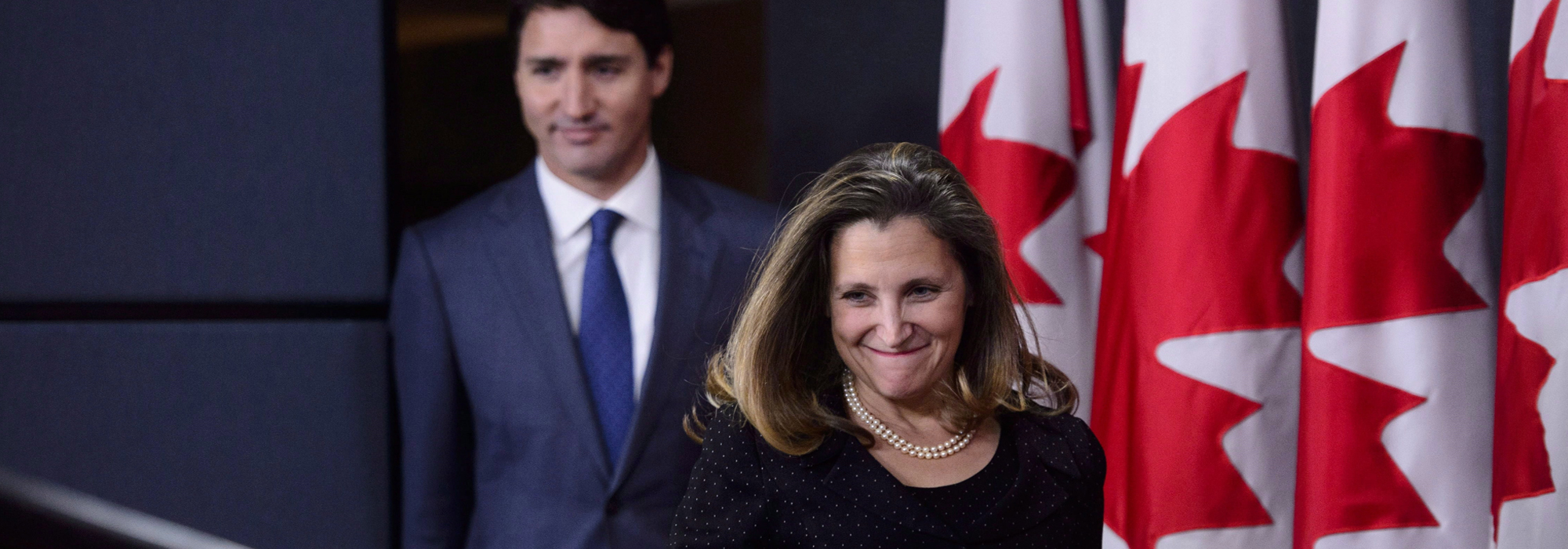
The Trudeau government entered NAFTA negotiations last August with an ambitious progressive trade agenda. Foreign Affairs Minister Chrystia Freeland used her testimony to the House of Commons International Trade Committee to explain that this meant strengthening labour and environmental rights, reworking dispute settlement, and adding new chapters on gender and Indigenous rights. A coalition of environmental, labour and civil society groups used the opportunity to outline their own broader requirements for trade negotiations that would foster inclusive and sustainable economic growth.
Trudeau and Freeland were criticized from the right for prioritizing politically correct virtue signalling that could make it harder to find a workable solution, given the number of other stumbling blocks in play and the economic importance of trade with the United States. Critics on the left were skeptical that Trudeau and Freeland were committed to meaningful reforms to a trade and investment agenda that has so often entrenched the rights of the economically powerful.
Now that the deal’s done and the dust is settling, how did the progressive trade agenda fare in the harsh reality of negotiations? In trade and investment deals, as in everything else, the details matter. It is difficult to call a deal a win when it continues to erode our supply management system, extends patent protections that will make medicines more expensive, and leaves damaging steel and aluminum tariffs in place.
But there are some welcome and surprising nuggets that will hopefully become a standard part of future trade agreements.
Indigenous rights
The idea for an Indigenous rights chapter in the agreement came from Assembly of First Nations National Chief Perry Bellegarde and is a first for a trade deal. Such a chapter might include provisions for trade within First Nations when their territory straddles the Canada-US border, protections for the rights of Indigenous peoples, or a framework for future Indigenous cooperation on trade issues. Negotiators worked closely with representatives from Indigenous groups on what should be included in Canada’s proposals.
The final text of the USMCA doesn’t have a separate chapter on Indigenous rights, but this agreement is far more advanced than NAFTA was on the issue. There are specific references to Indigenous peoples in the text on corporate social responsibility, in the chapter on small and medium-sized businesses, in the environment chapter, and the textiles chapter allows duty-free treatment for Indigenous handicraft goods.
Most importantly, there is a very clear general exception, sometimes called a carve-out, for Indigenous peoples’ rights in chapter 32. Article 32.5 says “nothing in this Agreement shall preclude a Party from adopting or maintaining a measure it deems necessary to fulfil its legal obligations to indigenous peoples.” This means that current and future obligations to Indigenous peoples in all three nations takes priority over any other part of the agreement, which is leaps and bounds better than the weak and partial exception in NAFTA.
Unfortunately, the footnote to this clause refers specifically to section 35 of Canada’s Constitution, and not the United Nations Declaration on the Rights of Indigenous Peoples, which would have made it even stronger.
Gender
Canada borrowed the idea for a gender chapter from Chile, which introduced the first ever trade and gender chapter in the Chile-Uruguay Free Trade Agreement in 2016. The updated Canada-Chile FTA and the updated Canada-Israel FTA both included trade and gender chapters modelled on the Chile-Uruguay chapter. The USMCA model does recognize the role of women in the economy, but only in vague and unenforceable statements, such as reaffirming their commitment to promoting gender equality and outlining possible areas of bilateral cooperation to encourage women’s equal participation in the economy. This type of chapter is largely symbolic anyway, so the failure to negotiate a gender chapter in USMCA is not much of a loss.
Gender is included in other areas of the USMCA to some extent, for example in the chapter on small- and medium-sized businesses the parties agree to collaborate on promoting small businesses owned by underrepresented groups, including women. A reference in the labour chapter to sex-based discrimination in the workplace extends and clarifies existing labour rights obligations on eliminating discrimination in the workplace.
In terms of gender, far more useful would be a process that considers the ways that our economy, foreign investment, and international trade impact human rights and gender equality, to help inform Canada’s broader negotiating strategy. An audit should be conducted prior to engaging in trade negotiations and could also be used to review impacts following the implementation of agreements. This exercise could identify groups that might be disproportionally impacted due to occupational segregation, existing wage discrimination, or disproportionate reliance on public services, similar to the “gender-based analysis plus” process that the federal government has committed to in developing the federal budget. To be most effective, all trade negotiators should be trained to conduct a gender and human rights audit of their areas of responsibility.
Labour rights
There are some small changes in language in the USMCA labour chapter that will hopefully make a meaningful difference for workers. For example, a new footnote clarifies that the right to strike is linked to the right to freedom of association, and there are articles that deal with violence against workers, migrant workers rights, and sex-based discrimination in the workplace.
The clause on migrant worker’s rights is an improvement on the existing standard, stating that “in implementing Article 23.3 (Labour Rights), each Party shall ensure that migrant workers are protected under its labour laws, whether they are nationals or non-nationals of the Party.” The labour laws referred to in this article include freedom of association, elimination of discrimination, and acceptable conditions of work with respect to minimum wages, hours of work, and occupational safety and health. Unfortunately, the text does not go as far as ensuring that migrant workers receive the same protections as domestic workers.
The article on sex-based discrimination in the workplace is a good example of including references to gender throughout the agreement, and provides useful context to the labour rights obligation 1(d), the elimination of discrimination in respect of employment and occupation.
A bigger change is the annex to the labour chapter that outlines obligations regarding worker representation in collective bargaining. There were labour market inequalities in Mexico that were made worse by NAFTA in 1994. The biggest issue is that most workers in Mexico are covered by “protection contracts,” which are agreements between the company and a company-approved union. These agreements keep wages low, allow companies to ignore their responsibilities toward the health and safety of workers, and generally keep workers in the dark about their rights and how to access them. Very few workers are represented by independent and democratic labour unions, and union organizers often face harassment and threats. Article 23.7 on violence against workers seems to be written to address this specific situation.
The labour chapter text put forward by Canada proposed language on democratic labour union representation and free collective bargaining, and United States House Democrats made it one of their negotiating priorities. As incoming Mexican president Andrés Manuel López Obrador has signalled his willingness to work on legislative reforms for workers, we can be optimistic that this annex will be a blueprint for much needed democratization of labour law and practice for Mexican workers.
Finally, the labour chapter is enforceable through the agreement’s state-to-state dispute resolution mechanism in chapter 31. It’s not yet clear how this will play out. The USMCA labour chapter uses language from previous US labour chapters that has made it extremely difficult, if not impossible, to establish whether a labour violation is linked to the free trade agreement. To address this, the USMCA text adds a footnote that should make it possible to build a successful case. In a positive move, chapter 31 also requires that in a labour dispute at least one panellist must have experience in labour law or practice.
Environment
Disappointingly, USMCA does not address the elephant in the room, climate change. What we needed for a progressive agreement was a complete carve-out for climate adaptation and mitigation policies required to meet our Paris Climate Targets. What we got was a weak reference to the importance of multilateral agreements.
The chapter is enforceable, again through chapter 31, and as in the labour chapter, any panel hearing a dispute on the environment chapter must include at least one panellist with expertise in environmental law or practice.
Probably the most important element of the USMCA for environmental protection is the phasing out of NAFTA’s investor state dispute settlement mechanism. Since its introduction in NAFTA 1994, it has been used by foreign investors to dispute a wide variety of environmental and public safety measures – such as bans on fracking in the St. Lawrence river basin, environmental assessments, and the sale and use of harmful additives, herbicides, and pesticides. So, it will be a relief for many that between Canada and the United States at least, this mechanism will be eliminated three years after the USMCA is implemented.
The negotiation process around the USMCA was quite open, with frequent briefings offered to a broad range of stakeholders. Negotiators were available to answer questions and listen to concerns and objections. In what was a very challenging context, the final text of USMCA makes important strides forward on dispute settlement, Indigenous peoples’ rights, and labour rights. Less substantial progress was made on gender and environment rights. Almost no progressive progress was made on broader issues such as regulatory harmonization and the protection of current or new public services, which is so integral to an inclusive economy.
We must work to make sure that the concrete steps forward in the USMCA become the new standard for international trade and investment agreements and are a solid first move toward building a trade agenda that puts people first.
Photo: Prime Minister Justin Trudeau and Minister of Foreign Affairs Chrystia Freeland arrive to hold a press conference regarding the United States Mexico Canada Agreement (USMCA) at the National Press Theatre, in Ottawa on Monday, Oct. 1, 2018. THE CANADIAN PRESS/Sean Kilpatrick
Do you have something to say about the article you just read? Be part of the Policy Options discussion, and send in your own submission. Here is a link on how to do it. | Souhaitez-vous réagir à cet article ? Joignez-vous aux débats d’Options politiques et soumettez-nous votre texte en suivant ces directives.









